Top Effective Sprays to Repel Wasps and Hornets


Intro
In the realm of home pest control, few nuisances are as bothersome as wasps and hornets. Their unexpected appearances can lead to quite the disruption, often resulting in painful stings. This article will provide you with the insights needed to effectively repel these pests using sprays that are designed specifically for this purpose. We will explore the various options available, both chemical and natural, and highlight the importance of safety and proper application methods.
Understanding the nature and habits of these creatures is crucial. Awareness of prevention strategies can help reduce the likelihood of infestations. Finally, we will delve into treatment options that you can employ to regain control of your outdoor spaces, all while keeping in mind the well-being of your family and the environment.
Pest Identification
Before diving into sprays and treatments, it is vital to identify the pests you are dealing with. Wasps and hornets are often misunderstood, and knowledge of their characteristics can aid in effective repelling.
Detailed Descriptions of Common Pests
- Yellowjackets: Recognizable by their black and yellow striped bodies, yellowjackets are among the most aggressive wasp species. They often make nests underground or in wall voids.
- Bald-Faced Hornets: This pest features a primarily black body with white markings on the face and abdomen. Known for their aerial nests, bald-faced hornets tend to be territorial, especially during late summer.
- Paper Wasps: These wasps have elongated bodies, often reddish-brown or yellow in color. Their nests resemble an open honeycomb and are usually found hanging under eaves and other sheltered spots.
Signs and Symptoms of Infestations
Detecting an infestation early is crucial. Signs may include:
- Unexpected sightings: If you see frequent wasps or hornets in your garden or near your home, it may indicate a nearby nest.
- Nesting structures: Look for nests hidden in trees, bushes, or under eaves.
- Aggressive behavior: If these pests exhibit territorial behavior, it likely points to a nest nearby.
Prevention Strategies
Prevention is often the most effective way to deal with wasps and hornets. Taking measures to reduce their appeal can significantly decrease the chances of infestations in your home.
Home Maintenance Tips for Pest Prevention
- Secure trash containers: Always use bins with tight-fitting lids to minimize food sources.
- Seal entry points: Patch any holes in your home's exterior to prevent access.
- Limit outdoor food waste: Clean up spills and leftovers promptly, especially during picnics or barbecues.
Natural Deterrents and Barriers
Utilizing natural ingredients can discourage these pests. Consider these options:
- Peppermint oil: A powerful deterrent when mixed with water and sprayed around the home.
- Cucumber slices: Placing these around the perimeter may help repel wasps due to their aversion to the smell.
Treatment Options
When prevention fails, knowing your treatment options is essential. Both chemical and natural methods exist, each with its own pros and cons.
Overview of Chemical vs. Natural Treatments
- Chemical Treatments: Products such as Raid Wasp and Hornet Killer are formulated to target these pests effectively. They are useful for quick action but may pose risks to pets and the environment if not utilized properly.
- Natural Treatments: Using soap and water, which disrupts the pests' ability to fly, can be an eco-friendly option. Other natural repellents include vinegar and essential oils.
Step-by-Step Guides for DIY Treatments
When opting for a DIY approach, follow these steps for application:
- For Natural Sprays: Mix two tablespoons of liquid dish soap with water in a spray bottle. Shake well and spray directly at wasp or hornet nests during early morning or late evening when they're less active.
- Using Chemical Sprays: Ensure you wear protective clothing. Stand a safe distance away and aim for the nest. Follow instructions on the label precisely.
Whether you choose chemical or natural methods, always prioritize safety, ensuring you're wearing protective gear and taking necessary precautions.
As we progress through this article, you will gain a deeper understanding of how to deter these pests effectively, ensuring a safer environment for you and your loved ones.
Understanding Wasps and Hornets
Understanding wasps and hornets is crucial for effective pest control. These insects can be a nuisance, especially during warmer months when outdoor activities increase. A solid grasp of their behavior and habitats helps homeowners devise strategies to repel them. Knowledge of the ecology of these pests contributes to more informed decisions regarding safety and effective repellent methods.
Behavior and Habitat
Wasps and hornets exhibit distinct behaviors adapted to their environments. Both types of insects are social creatures, often living in colonies. They build nests from paper-like material made from chewed wood fibers. Nests can be found in various locations such as trees, shrubs, or man-made structures.
While wasps are typically more aggressive in late summer when food sources dwindle, hornets may defend their nests more vigorously. Understanding these behaviors allows for better timing when applying repellent sprays. For example, the best time to spray is early in the morning or late afternoon when insects are less active. Recognizing their nesting sites is also essential in identifying where to apply the repellent.
Common Species
Several species of wasps and hornets are prevalent, each varying in behavior and aggression. The Yellow Jacket is among the most notorious. They are easily recognized by their black and yellow coloring and are known for their aggressive nature, especially around food. Another common type is the Paper Wasp, identifiable by their slender bodies and long legs. They are generally less aggressive unless provoked.
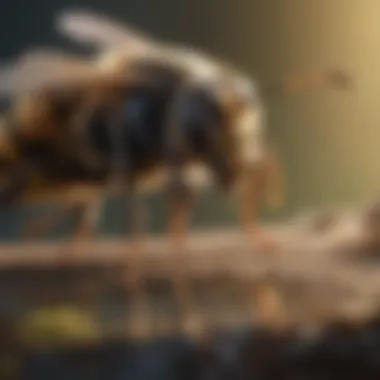
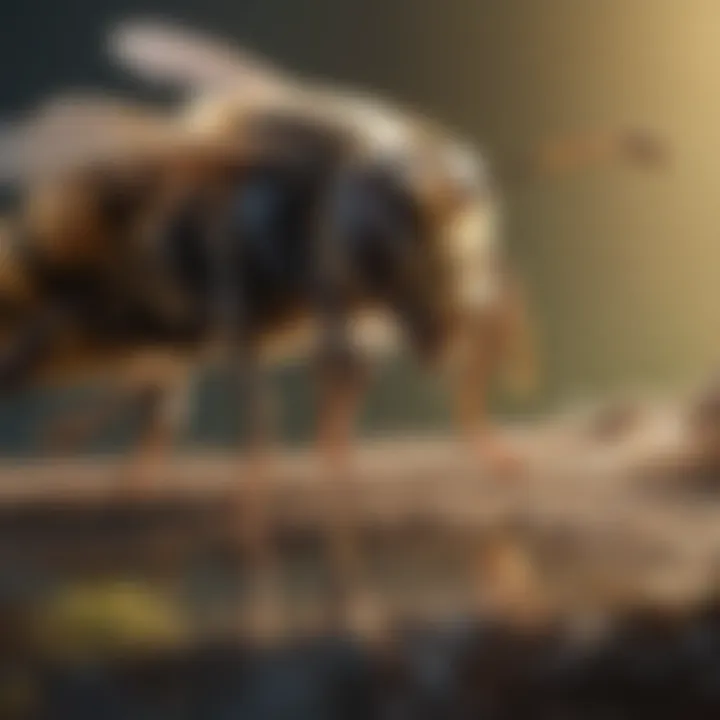
Hornets, like the Bald-Faced Hornet, are another type worth mentioning. They build aerial nests and can be very defensive of their territory. Each species comes with its unique challenges regarding control and prevention. Knowing which species is present can help in selecting the appropriate spray and approach for effective repelling.
The Importance of Repellent Sprays
Repellent sprays play a crucial role in managing wasp and hornet populations near residential areas. These insects can pose significant threats, both through their painful stings and the potential for allergic reactions in sensitive individuals. Therefore, having effective products designed specifically to deter these pests is essential for maintaining personal and family safety, as well as for ensuring a peaceful home environment.
Reasons for Using Sprays
Utilizing repellent sprays can bring numerous benefits. Some of the primary reasons include:
- Immediate Results: Sprays often provide a quick solution when an infestation is detected. Their fast-acting formulas can create a barrier that repels these insects almost instantly.
- Ease of Use: Most repellent sprays come in user-friendly containers allowing homeowners to apply them precisely where needed. This convenience is especially important for people who might not be comfortable handling large or live traps.
- Versatility: Many sprays can repel not only wasps and hornets but also a range of other pests, making them a multipurpose option for pest control.
- Prevention: Regular application can help create a protective shield around outdoor areas, keeping gatherings and barbecues safe from uninvited guests.
"A proactive approach to pest control not only limits infestations but increases the comfort of outdoor activities."
Safety Considerations
While repellent sprays are effective, safety remains a high priority. Homeowners should be mindful of several safety aspects:
- Chemical Ingredients: Many commercial sprays incorporate synthetic chemicals. It is vital to read labels carefully to understand their potential impacts on both health and the environment. Look for products that are labeled as safe for residential use.
- Application Environment: Always apply sprays in well-ventilated areas. Avoid spraying near food sources or areas frequented by pets and children to minimize risks of accidental exposure.
- Personal Protective Equipment: When using sprays, consider wearing gloves and long sleeves to prevent skin contact with potentially irritating ingredients. This practice is especially important when applying chemical sprays.
- Following Instructions: Carefully adhering to the manufacturer's instructions will greatly reduce risks. Misuse or overdose can not only reduce the efficacy of the spray but also pose health risks.
By taking these considerations into account, homeowners can effectively repel wasps and hornets while maintaining a safe living environment.
Types of Sprays Available
In dealing with wasps and hornets, understanding the types of sprays available can significantly influence their effectiveness. Choosing the right spray can impact how quickly and effectively you can repel these insects. There are two main categories: chemical sprays and natural alternatives. Each type comes with its specific benefits and considerations.
Chemical Sprays
Active Ingredients
Chemical sprays often contain active ingredients that are designed to target the nervous systems of insects. Common ingredients include pyrethroids, which are synthetic versions of natural insecticides found in chrysanthemum flowers. These active ingredients are favored because they are effective at quickly immobilizing or killing wasps and hornets on contact.
One key characteristic of these active ingredients is their fast action. They can eliminate pests almost immediately, making them a popular choice for urgent situations. However, there are downsides. For instance, while they are potent, they may pose risks to non-target species, including beneficial insects and pets, if not used properly. Therefore, the selection of a specific product should consider its ingredients and their potential environmental impact.
Application Techniques
The methods of applying chemical sprays can greatly affect their efficiency. Proper application techniques include aiming the spray directly at the nest or areas where wasps congregate while considering wind direction. A key characteristic is the design of the nozzle, which often allows for aimed delivery up to 20 feet away, minimizing the need to approach nests closely.
The unique feature here is the ability to apply these sprays at various times - during early morning or night when wasps are less active. Though effective, improper application can lead to inadequate coverage, resulting in less effective pest control. Users must follow instructions carefully to mitigate these risks.
Natural Alternatives
Essential Oils
Natural alternatives such as essential oils represent a safer choice for those concerned about chemical exposure. Many essential oils like peppermint, clove, and lemongrass have been shown to repel wasps and hornets due to their strong scents. A key characteristic of essential oils is that they provide a more eco-friendly option, aligning with growing demands for sustainable pest control solutions.
While essential oils are less harmful to beneficial insects, their efficacy can vary. They may not kill wasps on contact but can effectively deter them when used in sufficient concentrations. The disadvantage is that they often require more frequent application compared to chemical options due to their shorter lasting effects under UV light or rain.
Homemade Solutions
Homemade solutions often consist of mixtures using readily available household products. Common ingredients might include dish soap mixed with water or vinegar. Such solutions serve both as repellents and deterrents. The key characteristic of homemade solutions is their cost-effectiveness and reduced chemical load, which appeals to many homeowners.
The advantage of homemade solutions is that they can be easily tailored to individual preferences and availability of ingredients. However, the downside is their variability in effectiveness, which can depend on the specific ingredients used and how they are applied. Furthermore, achieving the right mixture can sometimes involve trial and error, which can be a drawback for some users.
Using sprays, whether chemical or natural, requires understanding their benefits and limitations to ensure successful pest control.
Application Techniques for Maximum Effectiveness
Understanding the right application techniques is crucial when it comes to using sprays for repelling wasps and hornets. The efficacy of a repellent is not solely dependent on its formulation but also on how it is applied. Employing proper techniques can significantly enhance the effectiveness of sprays while ensuring safety for both the applicator and the surrounding environment.
Effective spraying can deter these pests before they become a larger problem. It is essential to choose the right time and conditions to maximize the impact of the spray. Knowing when to apply the treatment can make a lot of difference in reducing the number of wasps and hornets.
Timing and Weather Conditions
Timing is a crucial factor in the application of repellent sprays. It is generally recommended to spray in the early morning or late evening when wasps and hornets tend to be less active. During these times, the pests are less likely to fly around and can be targeted more effectively. Moreover, weather conditions also play a significant role.
Slightly overcast days without rain are ideal for application. Windy conditions can cause the spray to drift, leading to ineffective coverage and waste of product. Furthermore, spraying during rainy weather can wash away the repellent, diminishing its effectiveness. Monitoring local weather forecasts before application is a smart move.
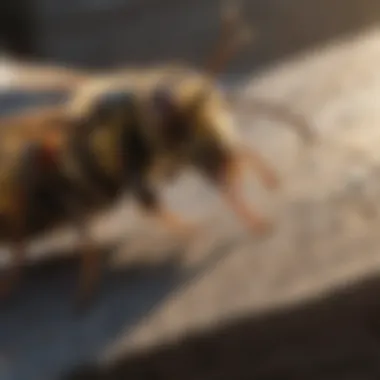
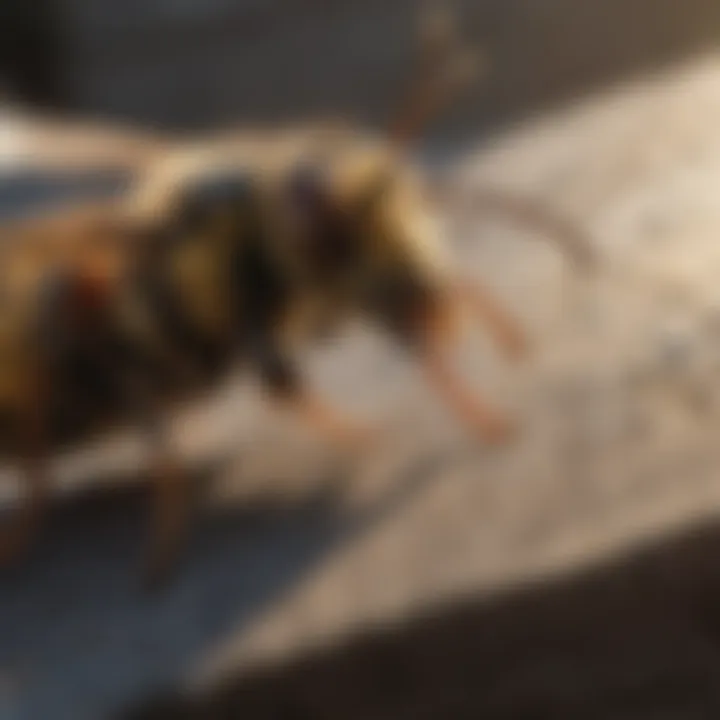
Targeted Spraying Techniques
Targeted spraying techniques are essential for ensuring that the repellent reaches the intended areas where wasps and hornets are likely to gather. Focus should be on points of entry such as eaves, porch ceilings, and outdoor furniture.
Adequate distance should be maintained while spraying. Most aerosol cans recommend holding them at least 10 to 15 feet away from the target to cover a wider area effectively. In addition to distance, it is also important to spray in a sweeping motion to avoid concentrating the product.
It is beneficial to check the instruction label on the spray product as different sprays can have varied application instructions. Be mindful of potential wind direction to prevent the spray from affecting unintended areas.
"Effective application of pest sprays can drastically reduce your issues with wasps and hornets over time."
Ultimately, revisiting and evaluating the techniques and timing is wise as pest activity may change based on weather conditions and seasonal habits. Understanding these application techniques not only increases the effectiveness of sprays but also aids in creating a safer environment for home inhabitants.
Preventive Measures Beyond Sprays
While effective sprays can significantly reduce the presence of wasps and hornets, they should not be the sole strategy for managing these pests. Preventive measures are equally essential in creating an environment that deters these insects from nesting near your home. With proper awareness and proactive steps, homeowners can minimize the likelihood of infestations. This section discusses crucial preventive actions that complement the use of repellents.
Nest Location Awareness
Understanding where wasps and hornets prefer to build their nests is vital for effective pest management. These insects often choose locations that provide shelter and protection. Common nesting sites include:
- Under eaves and roof overhangs: They seek dry, sheltered spots.
- In hollow trees or shrubs: Natural surroundings provide safety.
- Behind shutters or decks: These areas can be overlooked by homeowners.
By being aware of potential nesting areas, homeowners can conduct regular inspections. Look for signs such as aerial behavior indicating a nest nearby or the housing presence of these pests. If nests are found early, they can be dealt with before they grow in size and activity. Marking these locations can serve as a reminder for future inspections. This systematic approach plays a crucial role in minimizing a wasp or hornet presence.
Food and Garbage Management
Wasp and hornet attraction significantly increases with accessible food sources. It is essential to manage garbage and food waste effectively. This involves several strategies:
- Secure Trash Containers: Ensure garbage bins have tight-fitting lids.
- Keep Outdoor Eating Areas Clean: Promptly clean up food scraps and spills.
- Store Food Properly: Use airtight containers for outdoor food storage.
- Eliminate Scent Trails: Regularly wash areas where food is consumed to remove any odors that might attract these pests.
Utilizing these methods decreases the chances of attracting wasps and hornets. This can lead to a safer outdoor environment, thus reducing reliance on sprays. A clean environment not only deters pests but also promotes overall hygiene, benefiting all household members.
"Preventing infestations is often more efficient than dealing with them after they occur."
These preventive measures should be viewed as part of an integrated pest management strategy. Balancing chemical or natural sprays with these constructive actions ensures long-term effectiveness against wasps and hornets. Engaging in these practices reflects a comprehensive understanding of pest management that prioritizes both safety and efficiency.
Evaluating the Effectiveness of Sprays
Evaluating the effectiveness of sprays is a crucial component when dealing with wasps and hornets. It involves assessing how well these products perform in repelling or eliminating these pests. Effective evaluation provides homeowners with valuable insights into the success of their pest control measures and guides future decisions.
When considering the effectiveness of sprays, you must take into account various elements. These include the application method, the active ingredients, and the timing of the application. Understanding these factors allows for better decision-making regarding which spray to use.
Benefits of Evaluation
- Informed Choices: Homeowners can select the spray that best meets their needs by evaluating different products.
- Cost Efficiency: An effective spray reduces the need for repeated applications, saving money in the long run.
- Enhanced Safety: Understanding the results of a spray can lead to safer usage, minimizing exposure to chemicals.
Short-Term vs Long-Term Results
The distinction between short-term and long-term results is vital when evaluating the effectiveness of wasp and hornet sprays. Short-term results show the immediate impact a spray has on reducing pest numbers. This can be observed shortly after application where pests are visibly deterred or eliminated. However, long-term results are more significant in determining how well a spray helps in managing ongoing wasp and hornet issues.
Short-Term Results:
- Quick reduction in wasp or hornet activity.
- Immediate relief from the nuisance the pests pose.
Long-Term Results:
- Sustained decrease in pest populations over time.
- Prevention of infestations returning after initial treatment.
Assessing both aspects is necessary for homeowners who want lasting control. It also helps in identifying which products can be relied upon for future use.
Signs of Infestation Reduction
Identifying signs of infestation reduction is an important part of the evaluation process. Homeowners need to recognize the indicators that suggest their efforts in spraying are working. A drop in sightings of wasps or hornets can be a clear sign of effective pest control.
Indicators Include:
- Decrease in Nest Activity: A noticeable reduction in the number of wasps entering and exiting a nest suggests that a spray is effective.
- Fewer Stings or Signs of Aggression: If the frequency of encounters with aggressive behavior decreases, it indicates a successful deterrent effect.
- Dead or Dying Insects: Finding dead pests can confirm that the spray is killing or repelling the wasps or hornets.
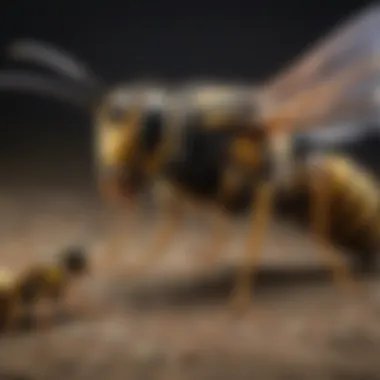
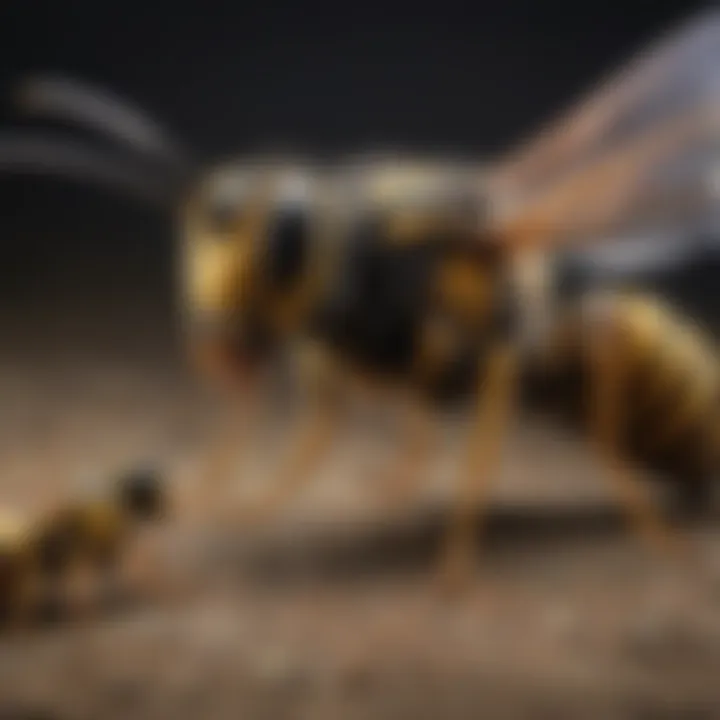
By closely monitoring these signs, homeowners can assess the success of their chosen sprays, enabling them to adjust their strategies or reinforce their pest control measures as necessary.
Potential Risks and Side Effects
Understanding the potential risks and side effects associated with using sprays to repel wasps and hornets is crucial for any homeowner. The effectiveness of these sprays is often highlighted, but one must also consider how they impact not just the intended pests but also the wider environment and household safety. This includes understanding how these sprays may affect non-target species and ensuring the safety of individuals within the home.
Impact on Non-Target Species
Sprays designed to repel wasps and hornets typically utilize active ingredients that can be harmful to various insects. Non-target species, which encompass pollinators like bees and butterflies, are particularly vulnerable. When using these sprays, the risk of accidentally harming beneficial insects increases.
- Take care when spraying near flowering plants; many sprays can affect bees which are essential for pollination.
- Some chemical components can persist in the environment, thereby affecting insect populations over time.
- Consider selecting products labeled as specifically targeting wasps and hornets to mitigate this risk.
Being conscious of the surrounding ecosystem can help maintain biodiversity while effectively managing pest populations.
Health Precautions for Humans
While repelent sprays serve an important purpose, it's essential to prioritize human health. Some individuals might experience adverse reactions to the chemicals contained in these products. To safeguard against potential health hazards, the following precautions are recommended:
- Read Labels Carefully: Understand the chemical ingredients and follow application instructions.
- Wear Protective Gear: When applying, consider wearing gloves and masks to avoid direct contact with skin or inhalation of fumes.
- Ventilate: Ensure proper ventilation in the area where the spray is used to minimize inhalation risks.
- Store Safely: Keep sprays out of reach of children and pets to prevent accidental exposure.
By adhering to these guidelines, you can use sprays effectively while minimizing health risks to yourself and others around you.
"Safety and environmental considerations are just as important as efficacy when managing pest control around your home."
Ultimately, awareness of both the potential risks and side effects of wasp and hornet sprays is vital. By taking informed steps, homeowners can effectively protect their spaces without compromising safety for themselves, their families, or beneficial insects.
Long-term Pest Management Strategies
Long-term pest management strategies are essential for effective control of wasps and hornets. Rather than relying solely on immediate sprays, these strategies emphasize a holistic approach to pest control. Soon after using sprays, the effectiveness can diminish over time if proactive measures are not implemented. Focusing on sustainable practices not only addresses current infestations but also prevents future occurrences. This approach is crucial for homeoweners looking to create a safe and comfortable environment.
One significant aspect of long-term pest management is the integration of various control measures. By combining chemical sprays with alternative methods, such as traps and habitat modification, you can create a multi-faceted strategy. This helps reduce reliance on just one type of treatment, enhancing overall effectiveness. Furthermore, it minimizes potential adverse effects on non-target species, addressing safety concerns.
In addition, a thorough pest management strategy aids in understanding and adapting to the pest's lifecycle and behavior. Different species of wasps and hornets display various behaviors. Recognizing these can inform not just the choice of sprays but also the timing and methods of application for best results.
"Long-term strategies provide a structured framework for handling pest issues while promoting safety and balance in the ecosystem."
Ultimately, the benefits of long-term pest management strategies include reduced infestations and more sustainable living conditions. This strategy also often translates into cost savings as it can diminish the need for repeated sprays and treatments over time. Additionally, by actively engaging in preventive practices, homeowners can enjoy the peace of mind that comes with minimizing the risk of future infestations.
Integrating Sprays with Other Controls
Integrating sprays with other pest control methods maximizes the effectiveness of the overall approach. This integration involves understanding how different methods can complement each other. Chemical sprays eliminate immediate threats but do not address the root causes of infestations, such as food sources and potential nesting sites.
Traps designed for wasps and hornets can be utilized alongside sprays to catch pests before they invade your space. These devices can be placed strategically around the yard or home. They help in monitoring populations, allowing you to take action before infestations escalate. For instance, combining baited traps with sprays creates a two-pronged method that significantly increases your chances of reducing wasp and hornet numbers.
Additionally, habitat modification techniques are effective. This includes removing potential nest sites and securing outdoor food waste. Sprays can be less necessary when the environment is less inviting to these insects. Thus, integrating these strategies fosters a more comprehensive understanding of pest dynamics.
Monitoring and Follow-Up
Monitoring and follow-up are critical components of any pest management strategy. After applying sprays, it is vital to observe for signs of remaining wasps or hornets. This monitoring helps to identify whether your methods have been effective and if further action is required. It allows for timely adjustments to your management approach based on real-time data about pest behavior.
Regular inspections of the yard and surrounding areas should be scheduled, particularly during warm months when wasps are most active. Look for any signs of nest construction or swarming behavior. This vigilance can prompt necessary and timely interventions.
Additionally, documenting your findings can be beneficial. Keeping records of pest sightings, spray applications, and changes in strategy can inform future pest management efforts. If a significant infestation continues despite these efforts, it may indicate the need for professional intervention. Therefore, understanding when to escalate your response is crucial for effective long-term management.
Culmination and Recommendations
In the discussion of methods to repel wasps and hornets, the final section plays a significant role. This is where we synthesize the information shared throughout the article. It encapsulates the best practices for utilizing effective sprays and offers guidance on how to integrate these solutions into broader pest management strategies.
When considering the use of sprays, one must weigh their efficacy against potential health risks. Safety is paramount. It's crucial to follow the instructions on the product labels and take precautions to protect both humans and pets from exposure. Integrating natural alternatives may offer a more eco-friendly solution, though chemical sprays can provide immediate relief in urgent situations. It’s essential to evaluate each scenario individually and choose a method that aligns with both effectiveness and safety concerns.
Summary of Key Points
- Understanding Behavior and Habitat: Knowing where wasps and hornets live can aid in prevention and targeting.
- Types of Sprays: A range of products exists, from chemical solutions like Raid Wasp & Hornet Killer to natural alternatives such as peppermint oil.
- Application Techniques: Proper timing and techniques increase the effectiveness of sprays. Always apply in the early morning or late evening when these pests are less active.
- Long-Term Strategies: Sprays should not be the only method. Awareness of nest locations and management of food sources are vital to long-term control.
- Potential Risks: Consider the impact on beneficial insects and take necessary health precautions, particularly for allergic individuals.
By summarizing these points, readers can appreciate the importance of a comprehensive approach to managing wasps and hornets. The key is not just to repel but to reduce chances of future infestations through preventive measures.
Final Thoughts on Pest Control
Pest control, especially with respect to wasps and hornets, requires careful consideration of various factors. The choice between chemical or natural sprays should not be made in haste. Instead, assess personal values regarding health, safety, and the environment. The best solutions arise from a combination of efforts including prevention, immediate action, and monitoring.
Utilizing effective sprays against wasps and hornets can protect homes and families. However, it is only as effective as the strategies deployed alongside them. Maintaining cleanliness, sealing food sources, and being aware of seasonal changes can significantly bolster the protective measures initiated by spray use.
Ultimately, a thoughtful approach to pest control not only addresses current infestations but also sets a firm foundation for avoiding future complications. This knowledge ensures a safe and more comfortable living space.



